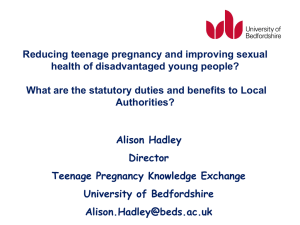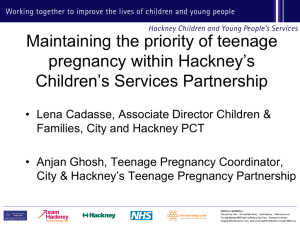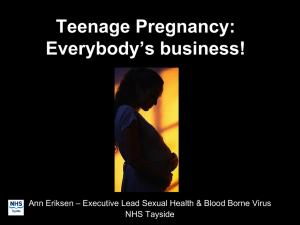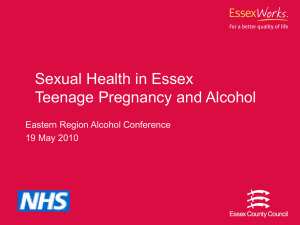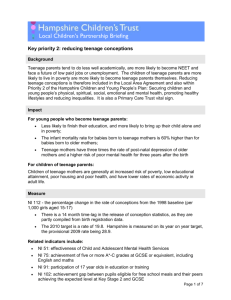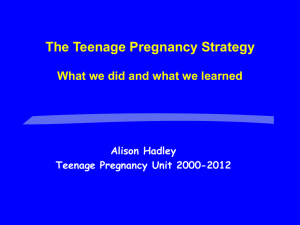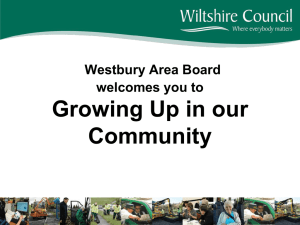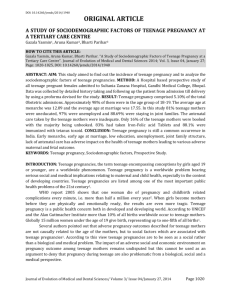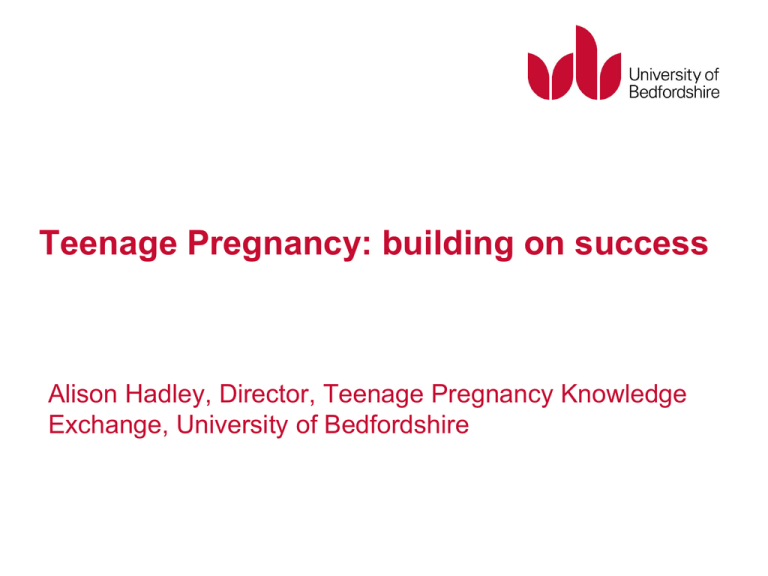
Teenage Pregnancy: building on success
Alison Hadley, Director, Teenage Pregnancy Knowledge
Exchange, University of Bedfordshire
The reasons for a teenage pregnancy strategy
and progress to date
A reminder of the reasons for a
Teenage Pregnancy Strategy
• Poor outcomes for young parents and their children
• The majority of under 18 conceptions are unplanned
• A key public health issue of health and educational
inequalities
• Historically high rates compared with similar Western
European countries and no sustained downward trend
Teenage Pregnancy Strategy:
the goals
Halve the under 18 conception rate from 1998-2010 to bring
the rate in line with Western European countries
Improve outcomes for teenage parents and their children,
measured by increasing proportion of 16-19 mothers in
education, employment or training
10 year strategies in each of the 150 local government areas
with a local 2010 reduction target. If all areas met the target
the 50% national goal would be achieved
England progress: 1998-2011
▪ 34% reduction in under 18 conception rate
▪ >70,000 under 18 conceptions avoided if conception rate had
remained the same as 1998
▪ Lowest under 18 conception rate in England since 1969
Local Progress | 1998-2011
30
20
Percentage change in rate
10
0
-10
-20
-30
-40
England
-50
-60
-70
Top-tier local authorities
Doncaster
Milton
Keynes
Bracknell
Camden
47% LAs have reduced rates more than the England average,
53% less. London has the largest reduction (44%). East and
North West the lowest (30%)
6
Why the work needs to continue
We’re only two thirds of the way towards the original aim to
bring rates down to levels experienced by young people in
similar Western European countries
Outcomes for young parents and their children remain
disproportionately poor
A continuing priority: the new policy context
A continuing priority:
the national policy context
▪ A Framework for Sexual Health Improvement in England:
- continue to reduce the rate of under 16 and under 18 conceptions one of
four priorities
Child Poverty Strategy:
- under 18 conception rate a measure of national and local progress
Raising the Participation Age:
- from 2013 all 17 year olds in education, training or work based learning
and all 18 year olds – until their 18th birthday - from 2015. Young parents
included in RPA duty
Children’s centres:
- improving outcomes for young parents and their children is central to
statutory guidance core purpose
Public Health Outcomes Framework:
- under 18 conception rate + other indicators disproportionately affecting
teenage parents and their children
Public Health Outcomes Framework
▪ Under 18 conception rate
▪ Chlamydia diagnosis (15-24)
Related indicators
▪ Children in poverty
(63% higher risk)
▪ Child development at 2-2.5 years
▪ Rates of adolescents not in education, employment or training
(NEET)(11% of all female NEETs are pregnant or teenage mothers)
▪ Proportion of people in long term unemployment(22% higher rates of
poverty for teenage mothers x2 rate of unemployment for young fathers
▪ Infant mortality rate (60% higher risk)
▪ Incidence of low birth weight of term babies (25% higher risk)
▪ Maternal smoking prevalence (including during pregnancy) (x3 smoking
rate)
▪ Breastfeeding initiation and prevalence at 6-8 weeks (1/3 lower rate)
▪ Hospital admissions caused by unintentional and deliberate injuries to
under 5s
▪ Sexual violence
Sticking to the evidence
Sticking to the evidence
• Provision of high quality SRE (Kirby 2007) and improved
use of contraception (Santelli 2008) are areas where
strongest empirical evidence exists on impact on teenage
pregnancy rates
• Universal and targeted. SRE and contraception provision
for all, with more intensive support for young people at
risk, combined with additional motivation to delay early
pregnancy – ‘means and motivation’
• No evidence that alternative approaches (e.g abstinenceonly/benefit conditionality) are effective in reducing
teenage pregnancy rates
Targeted support: identifying young
people who need early help
The strongest associated risk factors for pregnancy before 18
- Free school meals eligibility
- Persistent school absence
- Slower than expected progress between KS2 and KS3
7-9)*
(Years
(Teenage Pregnancy in England. DfE research report 2013)
Targeted support: identifying young
people who need early help
Other associated risk factors
Low maternal educational aspirations of daughter at age 10
also a risk factor
Looked after children and care leavers: 3 times rate of
motherhood <18
Young people who have experienced sexual abuse and
exploitation
Young people with conduct disorders and mental health
problems
Alcohol – association with under 18 conception and STIs,
independent of deprivation
The critical importance of universal
prevention
The majority of girls who conceive under 18 do not have specific
risk factors
“A teenage pregnancy prevention strategy that seeks to
reduce conception rates by a substantial margin cannot
concentrate on high risk groups alone. Although certain
girls are at much greater risk of conceiving and giving birth
as teenagers than others, the majority of girls that conceive
do not share these risk factors.”
(Teenage Pregnancy in England. DfE research report 2013)
Sticking to the evidence: national policy support
Translating evidence into a ‘whole systems’
approach: ten factors for an effective local strategy
SRE in schools
and colleges
Supporting
parents
to discuss sex &
relationships
Dedicated support
for teenage
parents –
including SRE
and contraception
Young people
friendly
contraceptive &
SH services
Clear and
consistent
messages
to young people,
parents and
practitioners
Strategic
leadership
&
accountability
Strong use
of data for
commissioning &
Local
performance
management
Workforce training
on SRE
Targeted SRE
and
contraception/SH
support for young
people at risk
SRE & access to
contraception in
youth services
Next steps on improving
sex and relationships education
• Sexual Health Improvement Framework:
• All young people receive appropriate information and education to enable
them to make informed decisions.
• All children and young people receive good quality SRE at home, at school
and in the community
• DfE PSHE Review:
• PSHE remains a necessary and important part of all pupils education
• All schools should teach PSHE
• All schools should deliver SRE in line with the statutory SRE guidance
• Ofsted: PSHE education makes ‘an outstanding and sustained
contribution to pupils’ spiritual, moral, social and cultural development’ but
…Ofsted PSHE report finds SRE required improvement in >1/3 schools
Measuring the local gap between
ambition and reality: some options
• A pupil audit of SRE in all schools, and PRUs, to identify
strengths, weaknesses and common themes for
improvement
• A parent audit in all schools to identify what information and
support they need to talk to their children and work in
partnership with the school
• An audit of teachers and school nurses to identify gaps in
skills and confidence
• A LA wide survey of young people to capture views of 16+ to
identify any gaps in knowledge and current sources of
information and support
• Engage support of local councillors
Improving access to contraception
and condoms
Sexual Health Improvement Framework
All young people have access to the full range of
contraceptive methods and know where to access them
Young people should be able to access condoms easily
and feel confident about carrying and using them.
Some questions to think about
Do all young people in your area know about and have
access to the full range of contraceptive methods + condoms
Are the services systematically publicised and trusted by
young people?
How can GPs and practice nurses help?
Workforce training:
making every contact count
Sexual Health Improvement Framework
Incorporate the prevention role of the wider non-health
workforce into commissioning
Join up sexual health services with other services and
practitioners supporting young people: drugs and alcohol,
mental health, sexual violence
Some questions to think about:
Is there multi-agency training reaching all practitioners,
particularly those supporting more vulnerable young people?
Do all services know about each other and how to support
swift referrals for young people?
The pregnancy pathway and improving support
for young parents
Mind the gap: is there a joined up
pregnancy pathway in your area?
Do all young people know about and have easy access to free
pregnancy testing and unbiased advice on pregnancy options
If abortion is the chosen option, do all young people have:
Swift referral to accessible NHS funded abortion service
Pre-abortion: access to accurate, unbiased information and a trained
counsellor if required, chlamydia screening and support with post abortion
contraception
Post abortion: access to trained counsellor if required, follow up
support on contraception and sexual health
The importance of a care pathway for
young parents: recommendations from
serious case reviews
“’In too many cases: there had been insufficient support for young parents‘
Young teenage parents need to be supported in an environment in which
they feel comfortable and supported. Adult centred services may not
achieve this without additional teenage focused services
Both parents need to be supported. The father is as important as the mother
and they need support to help them become good parents
There should be a joined up (multi-agency) approach to teenage pregnancy
and teenage parents with every agency understanding their role within it.
Planned and coordinated transfer of care between midwifery services, health
visitors, children’s centres and GPs is critical
Mind the gap: is there a joined up
care pathway for young parents?
If continuing the pregnancy is the chosen option
Swift referral to antenatal booking + information to support healthy early
pregnancy
Sensitive but robust pre-birth assessment/CAF in maternity services to
identify and address any problems early
Tailored antenatal care and preparation for parenthood for teenage
mothers and young fathers, including preparation for postnatal
contraception
Clear referral pathway between maternity services and dedicated
support in children’s centres, HVs or specialist local service
Co-ordinated support plan, tailored to individual need, with clear aim to
achieve good outcomes on health, emotional wellbeing and education for
both parents and their child – linked to LA wider programmes of
RPA, skills and employability and regeneration
The added value of positive messages
Messages for young people
Open and honest conversations about relationships and sexual
health help young people make well informed choices
Asking for contraception, sexual health advice or parenting
support is the right and responsible thing to do
No wrong door – all services and practitioners will try and help
We value young people and and want to support everyone to
develop and fulfil their ambitions
The added value of positive messages
Keeping everyone on board in a changing landscape
Teenage pregnancy engagement days for all health and nonhealth practitioners working with young people
6 monthly update meetings – lunchtime or twilight
Termly or 6 monthly newsletter
Establishing and maintaining a local website with up to date
information for young people, services and practitioners
Helpful resources
A Framework for Sexual Health in England (DH) (2013)
www.gov.uk/government/publications/a-framework-for-sexual-healthimprovement-in-england
Tackling teenage pregnancy: a briefing for councillors (2013)
Relationships and sex education: a briefing for councillors (2013)
http://www.local.gov.uk
Not yet good enough: Ofsted report on PSHE (2013)
http://www.ofsted.gov.uk/resources/not-yet-good-enough-personal-socialhealth-and-economic-education-schools
Ages of Concern: lessons from serious case reviews (Ofsted) 2011
http://www.ofsted.gov.uk/resources/ages-of-concern-learning-lessons-seriouscase-reviews
Statutory Guidance on the Participation of Young People in Education,
Employment or Training for LAs (2013)
www.education.gov.uk/childrenandyoungpeople/youngpeople/participation/
For more information:
Teenage Pregnancy Knowledge Exchange
www.beds.ac.uk/knowledgeexchange
alison.hadley@beds.ac.uk

